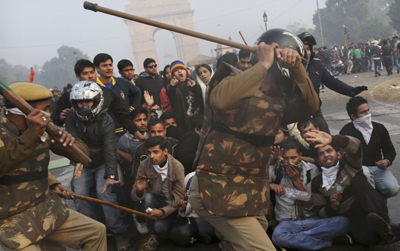For the safety of journalists and other people on the streets protesting injustice, Indian police must begin in earnest to address how they respond to demonstrations. One journalist died covering protests that have been taking place across the country following the gang rape of a 23-year old female medical student on a Delhi bus on December 16. The government’s response to these protests, in which more than 100 people have been injured, has raised eyebrows across the world.
The fatality was a cameraman for the news division of the Prime News channel, who was shot by police on Sunday in Imphal, the capital of the northeastern state of Manipur. The Associated Press identified the journalist as Dwijamani Singh. He died soon after police opened fire on protesters. Five police officers have been suspended, media reports said.
In the capital New Delhi, where thousands gathered last weekend, police fired tear gas and water cannons to disperse demonstrators and beat them with batons. Journalists were not spared. Water cannons hit several media crews, damaging their cameras and other equipment, according to local media reports. Some media workers were injured as a result of baton charges by the police, the reports said.
“Lots of journalists were affected. My cameraman and I were badly tear-gassed, and one colleague from another channel had a tear gas canister splinter in their leg and was taken to a hospital,” Nidhi Razdan, a journalist for NDTV covering the demonstrations in New Delhi, told CPJ by email. “Police used water cannons on some TV crews and their equipment too. Some of our equipment was damaged as well. I suffered after-effects for two days: an awful cough and headache. It went straight into my lungs.”
Fearing more violence, the government on Sunday prohibited protests and demonstrations in the area around India Gate and Raisina Hill–the main site of protests in the capital. Police also declared areas close to the president’s residence and the parliament off-limits on Sunday and detained those who defied the orders. All routes leading to landmark government buildings were closed and metro stations in the vicinity were shut. “We had to walk long distances to get to the venue of the protests. Many routes had zero access,” Razdan told CPJ. While protests have eased since the weekend and many traffic restrictions lifted, prohibitory orders against protesting remain in place, according to local media reports.
Nilanjana Roy, a New Delhi-based writer and journalist for Business Standard, who also attended the weekend protests, told CPJ, “Most of this response was unprovoked. It seems like it was an overreaction by the police,” she said about Saturday’s demonstrations, which were largely peaceful.
Police deny they overreacted. According to police, 78 officers were injured in clashes in New Delhi on Sunday, media reports said. In a television interview, Assistant Commissioner of Police Ajay Chaudhury of the southeast Delhi division said, “Government property has been damaged, stones have been pelted, one constable is on [a] ventilator, and what you’re saying is in this situation, should police not intervene?” The constable, Subhash Tomar, died of a heart attack on Tuesday; his death is still under investigation.
Covering India’s frequent demonstrations can be risky business. They can turn violent despite the intentions of their organizers. The police are often unable to control them without resorting to violence themselves. The recent clashes have led many Indians to demand that police be better trained in crowd control. Some media outlets reported that police lack basic training and that they beat peaceful protesters, including women.
This is not the first time a journalist has been killed in India while covering demonstrations. Another case is that of Javed Ahmed Amir, who was killed in August 2008 while covering protests during a spate of violence in the northern state of Jammu and Kashmir.
In a rare televised address on Monday, Indian Prime Minister Mammohan Singh urged calm following the weekend clashes in the capital. It would benefit his government to issue such calls for calm to police when they are attempting to manage such demonstrations.
UPDATE: This blog reflects the correct spelling of Dwijamani Singh’s name.
